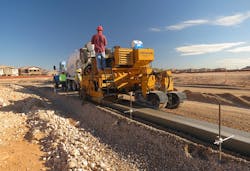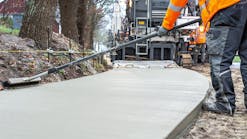Curb and Gutter Pavers See More Use of Stringless
Curb and gutter machines pave far faster than they go through significant model changes, but there have been two significant developments in the category since Construction Equipment last examined it: the development of a battery-electric remote-controlled curb machine and the growing acceptance of stringless curb and gutter work.
GOMACO showed its CC-1200e battery-electric model at the World of Concrete comeback event in Las Vegas in June 2021. It was touted as the world’s first fully electric concrete paving slipform machine.
No fuel required
“The framework of this machine is based on the diesel-powered CC-1200,” says Mark Brenner, GOMACO’s controls engineering manager. “And we’ve adapted this machine to hold 12 48-volt lithium-ion batteries that allows you to get a full day’s worth of paving. You have a couple of options for charging: You can do a two-hour quick charge or an overnight charge to get the batteries back to 100 percent.
“The benefits for electric are zero emissions, zero engine noise, and zero vibration from the engine,” Brenner says. “Fully automated controls are on the remote. We have auger, vibrator, steer, speed, travel, all wireless controlled.”
Just like on the company’s larger equipment, the CC-1200e features the GOMACO G+ control system.
Rotary-sensored slew drive steering on the front wheel assemblies is designed to provide maximum turning capability, smooth paving, and easy control, Brenner says. One variable-speed electric vibrator is coordinated with the stop switch that provides automatic on/off control of the vibrator that is synchronized with forward travel.
Performance-wise, the unit can pour a 24-inch radius, depending on the mold profile. It can pave up to 40 feet per minute and has an auxiliary speed of 93 feet per minute for mobility around the job site. Curb may be poured on either side of the machine.
Leg elevation of the slipform curb machine is controlled by three hydraulic cylinders with 10-inch stroke and an additional 5-inch manual adjustment. Molds are built to be interchangeable and can accommodate configurations that will fit within a 12-inch-wide by 14-inch-high section.
The CC-1200e is equipped with an E-stop (emergency stop) on every corner of the machine and on the remote control. It’s also equipped with an operator’s horn and back-up alarm to keep personnel safe during paving.
Last summer, a CC-1200e was demo’d in Knoxville, Tennessee, by England Contracting. England poured some 15,000 linear feet of curbing. “He gave us excellent feedback both during and after the pour,” Brenner says.
GOMACO is using the feedback to fine-tune the machine. It also showed a CC-1200e at the recent Bauma trade show in Munich, Germany. “We had a lot of interest and gained a lot of leads,” Brenner says.
As for plans to electrify other GOMACO equipment, Brenner says the company is always investigating new technologies. “We’re constantly looking at all power sources for our product lines, whether it be hybrid diesel electric, hydrogen, fully electric. We’ll meet our customers’ needs.”
Before looking toward the electric frontier, curb and gutter paver manufacturers had invested a lot of time and money in marrying GPS and related technology for stringless operation to their specific controls. Acceptance was slow at first for contractors brought up on traditional stringlines and staking, but OEMs report stringless has been gaining momentum because of users seeing the time and money savings, paving accuracy, and even versatility—units can run with or without stringline.
Stringless control
The M-1000 from Miller Formless is compatible with various technologies that support 3D stringless paving operations, as part of the manufacturer’s MFSmart Control Stringless package.
It was put to the test this past summer during the 2022 Street Reconstruction Program in Woodstock, Illinois. Nearly two dozen streets received improvements, part of a multiyear initiative.
Plote Construction of Hoffman Estates, Illinois, led the construction efforts, which included city street reconstruction, parking lot resurfacing, sidewalk repairs, and utility upgrades. Paving crews used the M-1000 concrete slipform paver to install 29,500 linear feet of barrier curbs (B6.12).
The crew’s initial response was positive.
“My equipment operator said the M-1000 rides like a Cadillac,” says Steven Childers, a civil engineer and the GPS manager at Plote Construction, where he has worked for nearly a decade. “He’s got 30 years of experience with curb machines, and he’s never had a curb machine that rode that smoothly.”
Plote Construction’s curb and gutter paver is equipped with two Topcon systems—mmGPS and LPS—which are solutions that augment grading activities by utilizing GNSS for horizontal accuracy and a rotating laser for vertical accuracy. This technology combination is meant to eliminate the need for stakes and stringlines—saving time and labor—and instead guides the machine along a “virtual stringline” with millimeter precision.
Topcon has offered specialty positioning systems for the last 25 years and works hand-in-hand with manufacturers such as Miller Formless to develop technologies that help contractors work smarter and faster.
Plote Construction is no stranger to stringless paving, having used the approach for many years on various dirt, asphalt, stone, and concrete projects—the 2022 Street Reconstruction Program in Woodstock, however, is the contractor’s first experience pairing GPS machine control with a slipform concrete curb and gutter paver.
“Honestly, I was very surprised at how easily the M-1000 held a grade and what a tight tolerance it held it in, too,” Childers says. Plote improved the versatility of its curbing machine by having the Topcon system wired for both millimeter GPS and local position system (LPS) functionality. The latter technology—for locations where satellite signals may be obstructed, such as tunnels or densely-built areas—uses a robotic total station for guidance to ensure accurate blade and screed positions.
Final touches on a curb and gutter job are another important consideration. According to Childers, Plote Construction’s finishing crews were “extremely happy” with how the Miller Formless M-1000 performed.
“Using the M-1000 gives us the versatility to run on stringline or skip the layout and run stringless,” Childers adds. “Having the option to do either makes us much more efficient as a company and helps us to reduce cost.”
Easi-Pour’s iSLIP Control System is an intelligent paving control system designed to better automate machine control and increase machine capabilities. iSLIP has a remote log-in and recordable feature designed for expediting troubleshooting and monitoring system functions. The remote feature allows our technicians to monitor the curb machine in real time.
Intelligent valving, iSLIP control and four-track independent steering and feedback contribute to creating a better finished product, the company says.
Wirtgen’s SP Series of offset slipform pavers (the company’s nomenclature for curb machines) work with steering via 3D control, which is an external system, or with the company’s own AutoPilot system.
When an external 3D system is used, digital, topographic data is compared to the machine's position data acquired through the total station. Deviations from the target position are processed by the interface for 3D control units into exact height and steering corrections, thereby ensuring highly precise driving behavior.
AutoPilot, a geodata-based data model that is either read-in externally or created at the construction site with the field rover pole.
The AutoPilot system then converts the data into a precise, virtual stringline, which provides the machine with all necessary height and steering information. This replaces the stringline and can be used in a flexible and time-saving way according to the conditions at the construction site.
Components of the system include GNSS sensors atop the paver to determine position and travel direction, intelligent software for automatic curve calculation, a dual-axis tilt sensor, a GNSS reference station for real-time machine control, and a total station for height control.
Complex profile forms can also be created right at the construction site in a short period of time. The system eliminates the need for complicated surveying, assembly, and disassembly of stringlines, and a geodata-based data model does not need to be created. AutoPilot 2.0 is available for the SP 15i and SP 25i, among other models.
Power Curbers' most recent introduction featuring stringless technology was the 5700-D, which has made a convert out of a veteran contractor used to running with stringline.
Jerry Bowman, of Bowman Contractors, Inc., in Aberdeen, Maryland, has paved using stringline since 1986. His decision to adopt the technology was measured and came over time.
“We’ve been watching this 3D/stringless move when it began several years ago,” Bowman says. “We heard a lot about it and read articles. Then we went to a demonstration at the [Power Curbers] factory. It was impressive and I liked it.
“We finally got to the point where we thought, ‘alright, we’ve got to get serious about this’ because our customers talked about it and asked about it,” Bowman says. “They were all using 3D on their site work. When the 5700-D came out, it looked great, the economy was good, and we said alright, it’s time. I had dragged my feet long enough and it was time to move forward.”
He says it was a scary transition—at first. “I knew nothing about 3D,” Bowman says. “None of us did. We didn’t have other equipment with 3D. The Topcon people were very supportive, so we went with them. Everybody from Power Curbers and Topcon was great. We dove in and started figuring it out. In the beginning, we were slow. We couldn’t move as well as we could with stringline, but we were learning. It has come along well.”
Bowman notes the company would send three or four people to stringline, which is also physical work, driving pins into the ground to setup. “On a good day, you’re setting between 1,000 and 2,000 feet of string,” he says. “With 3D, I send two guys to localize the job then we’re ready to go.
“When it comes to expense, we eliminate a complete curb stake-out, which benefits our customers,” Bowman says. “We also see savings on the stringline operation. You can compare three days of stringlining to a couple of guys localizing in half a day or less and a few hours building the alignment on the computer. Big parking lots with a bunch of islands, that’s where it really shines. Setting a stringline for a bunch of islands is a lot of work, a lot of labor. The machine did an excellent job.
“It is so accurate,” Bowman says. “You actually take the human error out of it.”






